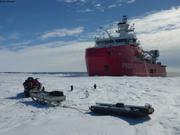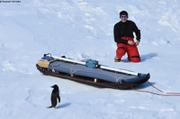First trip for the new Astrolabe
Here I am back on sea ice, this time in Antarctica. The red boat is moored to the ice edge. First we make a helicopter reconnaissance flight with the expedition leader. Then I get everything ready, the snowmobile, the sled, and the "icemeter" (EM31), needed to measure the thickness of the ice. My mission is to validate the route to the base of Dumont D'Urville, like in 2014. 50km to go on the frozen sea. Objective: 4 to 500 cubic meters of fuel oil to be unloaded, half of what is necessary to run French programs in Antarctica. The rest will be delivered during the next rotation of the ship, before March 2018 (early winter). There is emergency, the stocks of the bases are exhausted at the end of wintering, and last summer conditions have only allowed a minimum resupply.
On September 14th, 2017, the new Astrolabe was delivered to the French Navy. The red icebreaker will now be based in Reunion Island to resupply the French Antarctic bases in the summer (Dumont D'Urville and Concordia), and patrol the waters of the southern lands in winter (Kerguelen, Crozet, Saint-Paul and Amsterdam, Eparses). He thus replaces the old Astrolabe and the Albatross (on which I returned from Kerguelen in January 1995).
November 3rd: heavily loaded with oil and equipment, the polar patrol boat leaves Hobart, Tasmania, towards Adelie Land. Weight of the ship when loaded: more than 4000 tons. On board, 21 sailors and 43 passengers, embarked for the very first rotation. A first for the Navy as well, whose boats have not been south of the 60th parallel for 65 years.
November 7th: stop at Macquarie Island to drop about ten Australian scientists. The sea was rough, crew and passengers were well shaken, so we enjoy the opportunity to relax a few hours, sheltered by the island. A big male elephant seal approaches, 3 killer whales come nearby, and the albatrosses are faithful.
November 9th: arrival in the drifting pack ice, first contact with sea ice for the new Astrolabe, designed to break 80cm (class IB5). 4 engines for 9200CV in total.
November 13th: The Astrolabe reaches the ice edge, 60km from the base. We are welcomed by more killer whales and penguins! Bad weather suspends operations.
November 14th: One of the helicopters is taken out, test flight, mini reconnaissance, aerial photos, nothing more while waiting for a better weather window... we all look forward to disembark and do something!
November 16th: favourable weather! A dozen flights allow the helicopters to bring the mail (54 bags!) and some fresh food to the base (isolated since March 2017), then to transport eleven new winterers and summer scientists and technicians. Vessel side, refuelling operations are starting (R0, first rotation of the 2017-2018 season). The experienced IPEV team (French Polar Institute) is learning little by little to work with the Navy, watched by many curious penguins. And here we go for the seaice mission!
Read about the old Astrolabe: L'Astrolabe, le passeur de l'Antarctique, by Daphnée Buiron and Stéphane Dugast at E/P/A.


